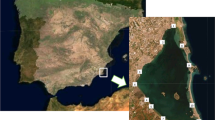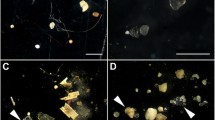Abstract
We have studied the recent history of organically bound tritium (OBT) and carbon-14 in suspended organic matter carried by the Rhône from the analysis of two cores collected in the sedimentary cone off the river mouth. Measured OBT and carbon-14 concentrations highlight characteristic anthropogenic traces in the suspended matter of the Rhône, with a peak of tritium and carbon-14 commencing at the start of the 1970s and extending over some 30 years. In spite of the influence of the atmospheric nuclear tests of the 1950s and 1960s, and of the discharges of carbon-14 by the nuclear industries located along the Rhône, carbon-14 levels are low due to the diluting effect of a refractory carbon component very low in carbon-14 present in the coastal sediments. OBT levels are well above the modern background created by the global imprint of bomb-tritium. Detailed study of the impact of the various contribution to the tritium peak indicates that these traces are mostly the result of the sediments in the Rhône being contaminated by past tritium releases by the watchmaking industry in the upper Rhône.










Similar content being viewed by others
References
Aloisi JC, Cambon JP, Carbonne J, Cauwet G, Millot C, Monaco A, Pauc H (1982) Origin and role of the bottom nepheloid layer in the transfer of particles into the marine environment. Application to the Gulf of Lions. Oceanol Acta 5(4):481–491
Antonelli C, Provansal M, Vella C (2004) Recent morphological channel changes in a deltaic environment. The case of the Rhone River France. Geomorphology 57:385–402
Baglan N, Alanic G, Le Meignen R, Pointurier F (2011) A follow-up of the decrease of non-exchangeable organically bound tritium levels in the surroundings of a nuclear research center. J Environ Radioact 102:695–702
Bentaleb I, Fontugne M (1996) Anthropogenic CO2 invasion of the surface Ocean: its influence on the organic carbon isotope composition of phytoplankton. C R Acad Sci Paris Ser IIa 322:743–748
Calder JA, Parker PL (1968) Stable carbon isotope ratio as indices of petrochemical pollution of aquatic systems. Environ Sci Technol 2:535–539
Cathalot C, Rabouille C, Tisnérat-Laborde N, Toussaint F, Kerhervé P, Buscail R, Loftis K, Sun MY, Tronczynski J, Azoury S, Lansard B, Treignier C, Pastor L, Tesi T (2013) The fate of river organic carbon in coastal areas: a study in the Rhône river delta using multiple isotopic (δ13C, ∆14C) and organic tracers. Geochim Cosmochim Acta 118:33–55
Cauquoin A, Jean-Baptiste P, Risi C, Fourré E, Stenni B, Landais A (2015) The global distribution of natural tritium in precipitation simulated with an atmospheric general circulation model and comparison with observations. Earth Planet Sci Lett 427:160–170
Charmasson S (2003) 137Cs inventory in sediment near the Rhone mouth: role played by different sources. Oceanol Acta 26:435–441
Charmasson S, Bouisset P, Radakovitch O, Pruchon AS, Arnaud M (1998) Long-core profiles of 137Cs, 134Cs, 60Co and 210Pb in sediment near the Rhone River (Northwestern Mediterranean Sea). Estuaries 21:367–378
Clarke WB, Jenkins WJ, Top Z (1976) Determination of tritium by mass spectrometry measurement of 3He+. Int J Appl Radiat Isot 27:515–522
Daillant O, Pigrée G, Gueidan C, Jacquiot L (2001) Recherche de tritium organiquement lié dans les lichens des environs de Valduc. Rapport de I’Observatoire Mycologique pour la Structure d’Echange et d’lnformation sur Valduc (SEIVA), Observatoire Mycologique, F-71250 Mazille
EDF (Electricité de France) (2007) Bilan 2007 des rejets radioactifs et chimiques des CNPE en exploitation et des réacteurs en arrêt définitif. Nucléaire & Environnement 2007 Report, EDF-Division Production Nucléaire
Eisma D, Bernard P, Cadée GC, Ittekkott V, Kalf J, Laane R, Martin JM, Mook WG, Van Put A, Schuhmacher T (1991) Suspended-matter particle size in some west-european estuaries: part I : particle size distribution. Neth J Sea Res 28:193–214
Eyrolle F, Charmasson S, Louvat D (2004) Plutonium isotopes in the lower reaches of the River Rhone over the period 1945–2000: fluxes towards the Mediterranean Sea and sedimentary inventories. J Environ Radioact 72:273–286
Eyrolle F, Ducros L, Dizès L, Beaugelin-Seiller S, Charmasson K, Boyer S, Cossonnet P, C (2018) An updated review on tritium in the environment. J Environ Radioact 181:128–137
Fontugne M, Calvert SE (1992) Late Pleistocene variability of the carbon isotopic composition of organic matter in the eastern Mediterranean: monitor of changes in carbon sources and atmospheric CO2 concentrations. Paleoceanography 7:1–20
Fontugne M, Jouanneau JM (1987) Modulation of the particulate organic carbon flux to the ocean by a macrotidal estuary: organic carbon isotopes evidence from the Gironde system. Estuar Coast Shelf Sci 24:377–387
Fontugne M, Paterne M, Calvert SE, Murat A, Guichard F, Arnold M (1989) Adriatic deep water formation during the Holocene. Implication for the re-oxygenation of the deep eastern Mediterranean Sea. Paleoceanography 4:199–206
Friedly H, Lötscher H, Oeschger H, Siegenthaler U, Stauffer B (1986) Ice core record of the 13C/12C ratio of the atmospheric C02 in the two past centuries. Nature 324:237–238
Gauthier C, Hatté C (2008) Effects of handling, storage and chemical treatments on 13C values of continental sediments. Geochem Geophys Geosyst 9(8):Q08011. https://doi.org/10.1029/2008GC001967
Gontier G, Siclet F (2011) Organic tritium in freshwater ecosystems: long-term trends in the environment of French nuclear power plants. Radioprotection 46:457–491
Gontier G, Grenz C, Calmet D, Sacher M (1992) The contribution of Mytilus sp. in radionuclide transfer between water comlumn and sediments in the estuarine and delta systems of the Rhône river. Estuar Coast Shelf Sci 34:593–601
Guétat P, Le Goff P, Boyer C, Duda JM (2013) Apports de la surveillance du centre CEA-Valduc sur la connaissance des transferts de l’eau tritiée atmosphérique dans les différents compartiments de l’environnement. Radioprotection 48:367–389
Harmelin-Vivien M, Dierking J, Banaru D, Fontaine MF, Arlhac D (2010) Seasonal variation in stable C and N isotope ratios of the Rhone River inputs to the Mediterranean Sea (2004–2005). Biogeochemistry 100:139–150
Hatté C, Poupeau JJ, Tatman JF, Paterne M (2003) Development of an automated system for preparation of organic samples. Radiocarbon 45:421–430
Jean-Baptiste P, Andrié C, Lelu M (1989) The diffusion of helium through glass. Glass Technol 30:228–230
Jean-Baptiste P, Baumier D, Fourré E, Dapoigny A, Clavel B (2007) The distribution of tritium in the terrestrial and aquatic environments of the Creys-Malville nuclear power plant (2002–2005). J Environ Radioact 94:107–118
Jean-Baptiste P, Fourré E, Dapoigny A, Baumier D, Baglan N, Alanic G (2010)) 3He mass spectrometry for very low-level measurement of organic tritium in environmental samples. J Environ Radioact 101:185–190
Jean-Baptiste P, Fontugne M, Fourré E, Marang L, Antonelli C, Charmasson S, Siclet F (2018) Tritium and radiocarbon levels in the Rhône river delta and along the French Mediterranean coastline. J Environ Radioact 187:53–64
Krejci K, Zeller A (1979) Tritium pollution in the Swiss luminous compound industry. In: Behaviour of tritium in the Environment. IAEA Proceedings series STI/PUB/498, pp 65–77
Lansard B (2004) Distribution et remobilisation du Plutonium dans les sédiments du prodelta du Rhône (Méditerranée Nord-Occidentale). Ph.D. thesis, Université de la Méditerranée Aix-Marseille II, pp 279
Lansard B, Charmasson S, Gascó C, Antón MP, Grenz C, Arnaud M (2007) Spatial and temporal variations of plutonium isotopes (238Pu and 239,240Pu) in sediments off the Rhone River mouth (NW Mediterranean). Sci Total Environ 376:215–227
Lansard B, Rabouille C, Denis L, Grenz C (2009) Benthic remineralization at the land-ocean interface: a case study of the Rhône River (NW Mediterranean Sea). Estuar Coast Shelf Sci 81:544–554
Le Guen B, Siclet F (2009) Impact du carbone-14 autour des centrales nucléaires EDF. Radioprotection 44:495–504
Monaco A, Courp T, Heussner S, Carbonne J, Fowler SW, Deniaux B (1990) Seasonality and composition of particulate fluxes during ECOMARGE-I, western Gulf of Lions. Cont Shelf Res 10:959–987
Mook WG, van der Plicht J (1999) Reporting C-14 activities and concentrations. Radiocarbon 41:227–239
Nydal R, Lövseth K (1996) Carbon-14 measurements in atmospheric CO2 from Northern and Southern Hemisphere, sites, 1962–1993. ORNL/CDIAC-93, NDP-057. Carbon Dioxide Information Analysis Center, Oak Ridge National Laboratory, Oak Ridge, Tennessee. https://doi.org/10.3334/CDIAC/atg.ndp057
Pont D, Simonnet JP, Walter AV (2002) Medium-term changes in suspended sediment delivery to the ocean: consequences of catchment heterogeneity and river management (Rhone River, France). Estuar Coast Shelf Sci 54(1):1–18
Radakovitch O, Charmasson S, Arnaud M, Bouisset P (1999) 210Pb and caesium accumulation in the Rhône delta sediment. Estuar Coast Shelf Sci 48:77–99
Reynolds RA, Stramski D, Wright VM, Wozniak SB (2010) Measurements and characterisation of particle size distributions in coastal waters. J Geophys Res 115:C08024. https://doi.org/10.1029/2009JC005930
Roussel-Debet S (2012) Constat radiologique Vallée du Rhône. Rapport final relatif au milieu terrestre. Rapport IRSN PRP-ENV/SESURE/2012-06
Roussiez V, Aloisi JC, Monaco A, Ludwig W (2005) Early muddy deposits along the Gulf of Lions shoreline: a key for a better understanding of land-to-sea transfer of sediments and associated pollutant fluxes. Mar Geol 222:345–358
Trundinger CM, Enting IG, Francey RJ, Etheridge DM, Rayner PJ (1999) Long-term variability in the global carbon cycle inferred from a high-precision CO2 and δ13C ice-core record. Tellus B 51:233–248
Author information
Authors and Affiliations
Corresponding author
Additional information
Publisher’s Note
Springer Nature remains neutral with regard to jurisdictional claims in published maps and institutional affiliations.
Rights and permissions
About this article
Cite this article
Jean-Baptiste, P., Fontugne, M., Fourré, E. et al. Organically bound tritium (OBT) and carbon-14 accumulation in the sediments off the mouth of the Rhône river. Environ Earth Sci 78, 78 (2019). https://doi.org/10.1007/s12665-019-8081-y
Received:
Accepted:
Published:
DOI: https://doi.org/10.1007/s12665-019-8081-y




